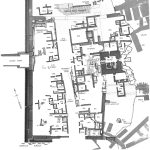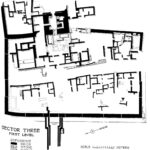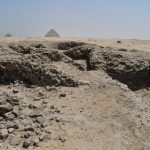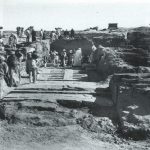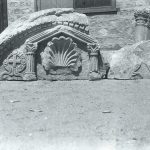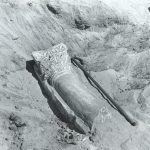SAQQĀRA (NORTH) (APA ANTINOS KOINOBION)
| Greek | Κοινοβίον τοῦ ἁγίου Ἄββα Ἀντίνου | Κοινοβίον Ἄπα Ἀντίνου |
| English | Monastery of Apa Antinos |
| DEChriM ID | 47 |
| Trismegistos GeoID | 61701 |
| Pleiades ID | - | PAThs ID | - |
| Ancient name | Apa Antinos Koinobion |
| Modern name | Saqqāra (North) |
| Latitude | 29.882442 |
| Longitude | 31.215832 |
| Date from | 375 |
| Date to | 550 |
| Typology | Monastic settlement |
| Dating criteria | - |
| Description | The so-called Monastery of Apa Antinos was situated on the ruins of a large temple dedicated to Nektanebo II (360-343BCE), located in the sacred animal necropolis of north Saqqāra. Denoted ‘Sector 3’ by the EES excavators, the area was divided in two by a north-south running main road, with an apparent disparity in wealth between the east and west sides (Emery 1970: 5 and pl. II). It is more likely, however, that they simply had different functions. The settlement included a church, domestic and presumably administrative structures, almost all of which was constructed directly on the Pharaonic monument, reusing some of the stonework (Emery 1969 pls. IX, 3 and 4), indicating an extended period of abandonment prior to the monastic reoccupation (Smith 1976: 14; Smith and Jeffreys 1977: 24). The earliest occupational phase identified corresponds to interments belonging to the Old Kingdom (Martin 1974: 16, 21-29; Smith and Jeffreys 1977: 26-27), with 30th Dynasty and Ptolemaic material also retrieved (Martin 1974: 18-19). Through the course of excavations, several textual documents have been recovered, which offer important glimpses, however partial, into the life of this monastic community. One text is of particular importance, that being a papyrus addressed to Apa Antinos, who is considered to have been the founder of the monastery (Gascou and Pintaudi 2000: 512-513). This text, and also the foundation of the monastery, is considered to belong to the end of the fourth/beginning of the fifth century (Martin 1974: 19; Smith 1976: 16; Smith and Jeffreys 1977: 25), meaning the community would predate that of the renowned monastery of Apa Jeremiah, though Peter Grossmann considered the monastery of Apa Antinos to simply be a branch of the former (Grossmann 2000: 250). For a description of the text, see Artefact no. 146. Situating the text at this time is supported by the datation of several other material elements, including lamps, one of which is included in the 4CARE database (artefact ID 1107), a cache of fourth century gold coins (Smith et al. 2006: 170, pl. LXXV; Emery 1967: 144; Emery 1969: 34), in addition to purportedly fourth century ceramic (Smith et al. 2006: 143; Smith and Jeffreys 1977: 26). Additionally, it has been posited that there was anchoritic reuse of some of the tombs in the cliff-face to the immediate east of the temple complex, occupation which has been considered datable to the third-fourth centuries based on ceramic material (Smith and Jeffreys 1977: 24). The areas mentioned specifically are Vaults J and P, with retaining walls having been built around the entrance to the former during this period. Although in the later synthesising publication of Smith et al. it is stated that Vault J was never investigated, it is nonetheless said that some tombs were reoccupied “during the Christian period”, suggesting that they could have been used by anchorites (Smith et al. 2006: 42, 152). The following chronology thus seems plausible: there was a late fourth-century anchoritic occupation of these tombs, which then led to the establishment of a modest, yet more formalised community founded by the named Apa Antinos. This was then converted into a koinobion sometime in the fifth century (Smith et al. 2006: 142). Others nonetheless consider a fifth century foundational date to be more likely (Lloyd 1979: 102-104; Bailey 2001: 121-122). Situated c. 30m south of the temple complex, in 'Sector 7', is situated a cemetery, comprising at least 160 graves and including several instances of burials of women and infants (Jeffreys and Strouhal 1980: 30). Anthropological analysis demonstrated that the mean age of death amongst the women is a-typically high, likely the result of an absence of child-bearing activity (Jeffreys and Strouhal 1980: 34). Though these were in later strata, their presence could indicate the presence of a female monastic community, while the few instances of child-burials remain open for interpretation. A notable feature of this cemetery was the fact that many of the burials were bound on reused grave planks taken from Saite and Greek-period burials, including one depicting the goddess Nut (Martin 1974: 21). Though interpreted as indicating the poverty of the community, it demonstrates also the methodological limitations of equating material culture with religious affiliation. The built remains of the monastic community are no longer present at the site, having been completely removed during the course of excavations (Emery 1970: 5). |
| Archaeological research | The only archaeological work to have been conducted at the site was that of the Egypt Exploration Society, which took place between 1964 and 1976. Work was first directed by W. B. Emery until his death in 1971. The same year, H. S. Smith was appointed the field director, and G. T. Martin was appointed as site director. Financial support included a grant from the British Academy for the first season (Emery 1969: 31). |
• Bailey, D. 2001. “Lamps from the Sacred Animal Necropolis, North Saqqara and the Monastery of Apa Antinos.” The Journal of Egyptian Archaeology 87: 119-133.
• Emery, W. B. 1967. “Preliminary Report on the Excavations at North Saqqara, 1966-7.” Journal of Egyptian Archaeology 53: 141-145.
• Emery, W. B. 1969. “Preliminary Report on the Excavations at North Saqqara, 1968.” Journal of Egyptian Archaeology 55: 31-35.
• Emery, W. B. 1970. “Preliminary Report on the Excavations at North Saqqâra, 1968-9.” Journal of Egyptian Archaeology 56: 5-11, pl. 2.
• Grossmann, P. 2002. Christliche Architektur in Ägypten, 250. Leiden: Brill.
• Gascou, J. and R. Pintaudi. 2000. “121-126. Les archives du monastère memphite d’Apa Antinos.” In Papyri in Honorem Johannis Bingen Octogenarii, edited by H. Melaerts, 511-520. Leuven: Peeters.
• Jeffreys, D. G. and E. Strouhal. 1980. “North Saqqara 1978-9: The Coptic Cemetery Site at the Sacred Animal Necropolis. Preliminary Report.” Journal of Egyptian Archaeology 66: 28-35.
• Lloyd, A. B. 1979. “Section G Coptic and Greek Inscriptions and Sealings.” In The Tomb of Ḥetepka and Other Reliefs and Inscriptions from the Sacred Animal Necropolis, North Saqqâra 1964-1973, edited by G. T. Martin, 102-120. London: Egypt Exploration Society.
• Martin, G. T. 1973. “Excavations in the Sacred Animal Necropolis at North Saqqara, 1971-2: Preliminary Report.” Journal of Egyptian Archaeology 59: 5-15.
• Martin, G. T. 1974. “Excavations in the Sacred Animal Necropolis at North Saqqara, 1972-3: Preliminary Report.” Journal of Egyptian Archaeology 60: 15-29.
• Martin, G. ed. 1979. The Tomb of Ḥetepka and Other Reliefs and Inscriptions from the Sacred Animal Necropolis, North Saqqâra 1964-1973. London: Egypt Exploration Society.
• Martin, G. T. 1981. The Sacred Animal Necropolis at North Saqqara. The Southern Dependencies of the Main Temple Complex. London: Egypt Exploration Society.
• Smith, H. S. 1976. “Preliminary Report on Excavations in the Sacred Animal Necropolis, Season 1974-1975.” Journal of Egyptian Archaeology 62: 14-17.
• Smith, H. S., S. Davies, and K. J. Frazer. 2006. The Sacred Animal Necropolis at North Saqqara. The Main Temple Complex. The Archaeological Report. London: Egypt Exploration Society.
• Smith, H. S. and D. J. Jeffreys. 1977. “The Sacred Animal Necropolis, North Saqqâra: 1975/6.” Journal of Egyptian Archaeology 63: 26-27.


 Json data
Json data
